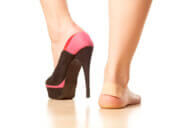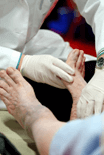





 Will wearing comfy running shoes add to the likelihood of foot injuries? According to mensjournal.com, this may be true. As you run in shoes, the intrinsic muscles, “or little muscles in your feet” often do little to no work. As a result, your feet may become prone to injury as your feet become used to the cushion in your shoes. Running barefoot can help strengthen your intrinsic muscles and your overall balance. Going barefoot is a beneficial activity, but must be eased into, especially if you haven’t exercised regularly while barefoot before. Mensjournal.com suggests a core workout for your feet to help ease the transition into barefoot running, which include strengthening your heels.
Will wearing comfy running shoes add to the likelihood of foot injuries? According to mensjournal.com, this may be true. As you run in shoes, the intrinsic muscles, “or little muscles in your feet” often do little to no work. As a result, your feet may become prone to injury as your feet become used to the cushion in your shoes. Running barefoot can help strengthen your intrinsic muscles and your overall balance. Going barefoot is a beneficial activity, but must be eased into, especially if you haven’t exercised regularly while barefoot before. Mensjournal.com suggests a core workout for your feet to help ease the transition into barefoot running, which include strengthening your heels.
Barefoot running has its own share of benefits and disadvantages. If you have any concerns about your feet contact one of our podiatrists of Active Foot and Ankle Care, L.L.C.. Our doctor will treat your foot and ankle needs.
Barefoot Running
The Impact of Barefoot Running
-Running without shoes changes the motion of your running, as most running is done by landing on the heel of the feet.
-Running barefoot requires a different way of running; the landing is done on the front part of the feet.
The Advantages of Barefoot Running
-When running and landing on the front feet, the impact on the feet and ankle is reduced; this can reduce stress injuries.
-It strengthens muscles in the feet, ankles and the lower legs.
-Balance of the body is improved and there is greater sensory input from the feet to the rest of the body.
The Drawbacks of Barefoot Running
-No protection while running makes it likely that runners will land on sharp objects and scrapes, resulting in bruises and cuts on the feet.
-Blisters may form.
-Possibility of plantar fascia problems.
-Risk of getting Achilles tendonitis.
So what can runners do to make barefoot running safe? It’s best to make a slow transition from running shoes to barefoot running. Once the feet begin to adjust, try walking, then jogging and gradually increasing the distance. Minimalist running shoes may also be an option.
If you have any questions, please feel free to contact our offices located in New Jersey. We offer the newest diagnostic tools and technologies to treat your foot and ankle needs.
 Dutch shoe designer Marloes ten Bhomer has created a conceptual high heel designed to contour the foot better than regular high heels. The shoe also supports the foot better than most shoes in general. In order to create the shoe, Bhomer researched cultural connotations of women’s footwear at the Stanley Picker Gallery at Kingston University in London. The shoe was also designed based on the natural movement of women’s feet, designed to move the wearer forward.
Dutch shoe designer Marloes ten Bhomer has created a conceptual high heel designed to contour the foot better than regular high heels. The shoe also supports the foot better than most shoes in general. In order to create the shoe, Bhomer researched cultural connotations of women’s footwear at the Stanley Picker Gallery at Kingston University in London. The shoe was also designed based on the natural movement of women’s feet, designed to move the wearer forward.
High heels have a history for causing foot and ankle problems. If you have any concerns about your feet contact one of our podiatrists of Active Foot and Ankle Care, L.L.C.. Our doctor will treat your foot and ankle needs.
Effects of High Heels on the Feet
High heels are popular shoes among women because their style and societal appeal. Despite this, they can still cause many health problems if worn too frequently.
What parts my body will be affected by high heels?
What kinds of foot problems can develop from wearing high heels?
How can I still wear high heels and maintain foot health?
If you want to wear high heeled shoes, make sure that you are not wearing them every day, as this will help prevent long term physical problems. Try wearing thicker heels as opposed to stilettos to distribute weight more evenly across the feet. Always make sure you are wearing the proper shoes for the right occasion, such as sneakers for exercising. If you walk to work, try carrying your heels with you and changing into them once you arrive at work. Adding inserts to your heels can help cushion your feet and absorb shock. Full foot inserts or metatarsal pads are available.
If you have any questions, please feel free to contact our offices located in New Jersey. We offer the newest diagnostic tools and technologies to treat your foot and ankle needs.
 Starting small forward Harrison Barnes of the Golden State Warriors will have to miss the game against the Kings because of a sprained left ankle injury. The details of his injury are unknown as the team awaits test results from his examination. Brandon Rush may be expected to sub in for Barnes. Barnes averages 50 percent in shooting and 38.9 percent behind the arc.
Starting small forward Harrison Barnes of the Golden State Warriors will have to miss the game against the Kings because of a sprained left ankle injury. The details of his injury are unknown as the team awaits test results from his examination. Brandon Rush may be expected to sub in for Barnes. Barnes averages 50 percent in shooting and 38.9 percent behind the arc.
Ankle sprains are common, but need immediate attention. If you have any concerns about your feet contact one of our podiatrists of Active Foot and Ankle Care, L.L.C.. Our doctor will treat your foot and ankle needs.
How Does an Ankle Sprain Occur?
Ankle sprains take place when the ligaments in your ankle are torn or stretched beyond their limits. There are multiple ways that the ankle can become injured, including twisting or rolling over onto your ankle, putting undue stress on it, or causing trauma to the ankle itself.
What are the Symptoms?
Preventing a Sprain
Treatment of a Sprain
Treatment of a sprain depends on the severity. Many times, people are told to rest and remain off their feet completely, while others are given an air cast. If the sprain is very severe, surgery may be required.
If you have suffered an ankle sprain previously, you may want to consider additional support such as a brace and regular exercises to strengthen the ankle.
If you have any questions, please feel free to contact our offices located in New Jersey. We offer the newest diagnostic tools and technologies to treat your foot and ankle needs.
 Dr. Michael Sisk, an orthopaedic surgeon at Steamboat Springs, advises taking care of your feet following foot and ankle injuries. It’s essential to act after sustaining an injury, and common treatments include surgery, physical therapy, stretching, and orthotics. Sisk recommends wearing shoes with good support to avoid sports injuries. Taking a break from physical activity is crucial to the healing of your injury, as well as seeing a doctor immediately after sustaining the injury.
Dr. Michael Sisk, an orthopaedic surgeon at Steamboat Springs, advises taking care of your feet following foot and ankle injuries. It’s essential to act after sustaining an injury, and common treatments include surgery, physical therapy, stretching, and orthotics. Sisk recommends wearing shoes with good support to avoid sports injuries. Taking a break from physical activity is crucial to the healing of your injury, as well as seeing a doctor immediately after sustaining the injury.
Sports related foot and ankle injuries need proper treatment before players can go back to their regular routines. If you have any concerns about your feet contact one of our podiatrists of Active Foot and Ankle Care, L.L.C.. Our doctor will treat your foot and ankle needs.
Sport Related Foot and Ankle Injuries
Foot and ankle injuries are a common occurrence when it comes to athletes of any sport. While many athletes dismiss the initial aches and pains, the truth is that ignoring potential foot and ankle injuries can lead to serious problems. As athletes continue to place pressure and strain the area further, a mild injury can turn into something as serious as a rupture and may lead to a permanent disability. There are many factors that contribute to sports related foot and ankle injuries, which include failure to warm up properly, not providing support or wearing bad footwear. Common injuries and conditions athletes face, including:
Sports-related injuries are commonly treated using the RICE method. This includes rest, applying ice to the injured area, compression and elevating the ankle. More serious sprains and injuries may require surgery, which could include arthroscopic and reconstructive surgery. Rehabilitation and therapy may also be required in order to get any recovering athlete to become fully functional again. Any unusual aches and pains an athlete sustains must be evaluated by a licensed, reputable medical professional.
If you have any questions, please feel free to contact our offices located in New Jersey. We offer the newest diagnostic tools and technologies to treat your foot and ankle needs.






